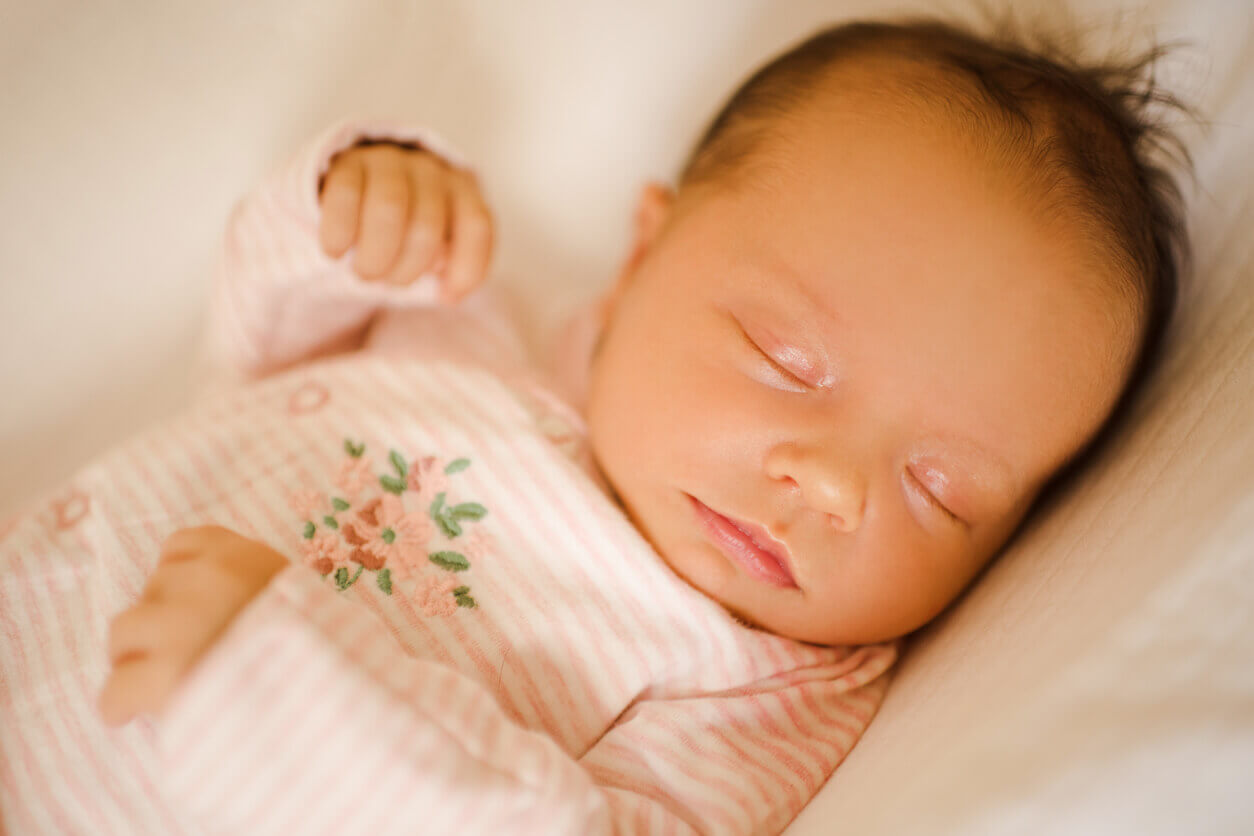When Do Babies Grow Their Definitive Hair?


Written and verified by the dermatologist Maria del Carmen Hernandez
The definitive hair of babies usually appears around 6 months of life. Together with hair color, it’s a distinctive feature that’s determined after an irregular and prolonged process. Each little one will be different and will develop at a different rate. However, there are some general criteria to keep in mind. Keep reading to find out when your baby’s final hair will grow in.
Types of hair during life
The color and amount of hair a newborn baby has is largely due to genetics. However, hormones influence the amount of hair a newborn baby has.
- Lanugo: Lanugo is characteristic of newborns, consisting of thin hairs that are shed inside the uterus or in the first days of life. In addition, it acts as a protective layer of the skin surface due to its lack of body fat. It appears in the 13th week of gestation from the head to cover the entire body.
- Hair: This is found in the areas of the body that seem not to have hair, however, they have thinner and shorter hairs that don’t have the medullary layer.
- Terminal hair: This is the most visible and dark hair. It’s the definitive hair that fulfills different stages of a cycle.
Read also: Baby hair: how to wash it and how often
The phases of definitive hair growth in babies

In general, hair growth develops around the 30th week of pregnancy. The baby’s hair begins to grow in the mother’s womb where hormone levels are high, and accelerate growth.
However, after delivery, hormone levels decrease at an accelerated rate and the baby’s hair growth slows down. Consequently, it enters a new growth cycle preceded by mild hair loss.
The growth cycle is composed of four distinct phases according to an article in the Journal of Cell Science.
Anagen
The anagen phase is the beginning of the stages of hair growth. It’s also the longest stage, typically lasting 3-5 years for head hair.
However, the length of this phase differs depending on the type of hair, i.e. pubic hair or eyebrow hair. In addition, the hair follicles are shedding hairs that will continue to grow until they end their cycle and fall out.
Catagen
At the end of the anagen phase, the catagen phase begins and tends to last for 10 days. The hair follicles even shrink and hair growth slows down.
Although the hair separates from the lower part of the hair follicle, it remains in place during the last few days of its development. In general, only 5% of the hair on the scalp is in the catagen phase.
Telogen
The telogen phase is characterized by lasting about 3 months in a resting state. In turn, during this phase, the hairs aren’t growing and don’t fall out.
In general, about 15% of the hairs are in this period.
Exogenous
This is known as an extension of the telogen phase in which hairs are shed from the scalp, often stimulated by brushing and rinsing.
Each phase of the hair cycle has its own timeline and can be altered by nutrition, age, and overall health.
You may be interested in: How to Cut Your Baby’s Hair?

Babies’ final hair after three months
After birth, babies lose almost all of their lanugo that developed in the womb as a method of protection. Therefore, around two months after birth, hairless areas may appear that will give way to stronger hair.
The terminal hair is the one that will be definitive and won’t change or fall out over time. It’s at this moment when the characteristics of the hair begin to be determined: Straight, curly, thick, or fine.
Definitive hair color
Babies have never been exposed to the sun’s rays at birth and have always been kept in the dark. Therefore, when they begin to have contact with the sun, the color of their hair may change.
This mutation of the tone is a gradual process and it’ll take a long time to establish a final hair color. That is, at around 2 years of age, children can present the definitive hair color.
Those babies who at birth have a fair complexion, tend to have a more delayed process of the development of their definitive hair.
Final considerations regarding definitive hair in babies
Baby hair has the ability to change several times over time, both in shape and color. In addition, there’s no scientific evidence that justifies cutting hair to stimulate its growth and vitality.
Therefore, cutting the hair of newborns is nothing more than a personal choice, as there’s no physiological basis for this practice.
The definitive hair of babies usually appears around 6 months of life. Together with hair color, it’s a distinctive feature that’s determined after an irregular and prolonged process. Each little one will be different and will develop at a different rate. However, there are some general criteria to keep in mind. Keep reading to find out when your baby’s final hair will grow in.
Types of hair during life
The color and amount of hair a newborn baby has is largely due to genetics. However, hormones influence the amount of hair a newborn baby has.
- Lanugo: Lanugo is characteristic of newborns, consisting of thin hairs that are shed inside the uterus or in the first days of life. In addition, it acts as a protective layer of the skin surface due to its lack of body fat. It appears in the 13th week of gestation from the head to cover the entire body.
- Hair: This is found in the areas of the body that seem not to have hair, however, they have thinner and shorter hairs that don’t have the medullary layer.
- Terminal hair: This is the most visible and dark hair. It’s the definitive hair that fulfills different stages of a cycle.
Read also: Baby hair: how to wash it and how often
The phases of definitive hair growth in babies

In general, hair growth develops around the 30th week of pregnancy. The baby’s hair begins to grow in the mother’s womb where hormone levels are high, and accelerate growth.
However, after delivery, hormone levels decrease at an accelerated rate and the baby’s hair growth slows down. Consequently, it enters a new growth cycle preceded by mild hair loss.
The growth cycle is composed of four distinct phases according to an article in the Journal of Cell Science.
Anagen
The anagen phase is the beginning of the stages of hair growth. It’s also the longest stage, typically lasting 3-5 years for head hair.
However, the length of this phase differs depending on the type of hair, i.e. pubic hair or eyebrow hair. In addition, the hair follicles are shedding hairs that will continue to grow until they end their cycle and fall out.
Catagen
At the end of the anagen phase, the catagen phase begins and tends to last for 10 days. The hair follicles even shrink and hair growth slows down.
Although the hair separates from the lower part of the hair follicle, it remains in place during the last few days of its development. In general, only 5% of the hair on the scalp is in the catagen phase.
Telogen
The telogen phase is characterized by lasting about 3 months in a resting state. In turn, during this phase, the hairs aren’t growing and don’t fall out.
In general, about 15% of the hairs are in this period.
Exogenous
This is known as an extension of the telogen phase in which hairs are shed from the scalp, often stimulated by brushing and rinsing.
Each phase of the hair cycle has its own timeline and can be altered by nutrition, age, and overall health.
You may be interested in: How to Cut Your Baby’s Hair?

Babies’ final hair after three months
After birth, babies lose almost all of their lanugo that developed in the womb as a method of protection. Therefore, around two months after birth, hairless areas may appear that will give way to stronger hair.
The terminal hair is the one that will be definitive and won’t change or fall out over time. It’s at this moment when the characteristics of the hair begin to be determined: Straight, curly, thick, or fine.
Definitive hair color
Babies have never been exposed to the sun’s rays at birth and have always been kept in the dark. Therefore, when they begin to have contact with the sun, the color of their hair may change.
This mutation of the tone is a gradual process and it’ll take a long time to establish a final hair color. That is, at around 2 years of age, children can present the definitive hair color.
Those babies who at birth have a fair complexion, tend to have a more delayed process of the development of their definitive hair.
Final considerations regarding definitive hair in babies
Baby hair has the ability to change several times over time, both in shape and color. In addition, there’s no scientific evidence that justifies cutting hair to stimulate its growth and vitality.
Therefore, cutting the hair of newborns is nothing more than a personal choice, as there’s no physiological basis for this practice.
All cited sources were thoroughly reviewed by our team to ensure their quality, reliability, currency, and validity. The bibliography of this article was considered reliable and of academic or scientific accuracy.
- Verhave BL, Nassereddin A, Lappin SL. Embryology, Lanugo. 2021 May 8. In: StatPearls [Internet]. Treasure Island (FL): StatPearls Publishing; 2021 Jan–. PMID: 30252348. Disponible en: https://pubmed.ncbi.nlm.nih.gov/30252348/
-
Grubbs H, Nassereddin A, Morrison M. Embryology, Hair. [Updated 2021 May 8]. In: StatPearls [Internet]. Treasure Island (FL): StatPearls Publishing; 2021 Jan-. Available from: https://www.ncbi.nlm.nih.gov/books/NBK534794/
This text is provided for informational purposes only and does not replace consultation with a professional. If in doubt, consult your specialist.








